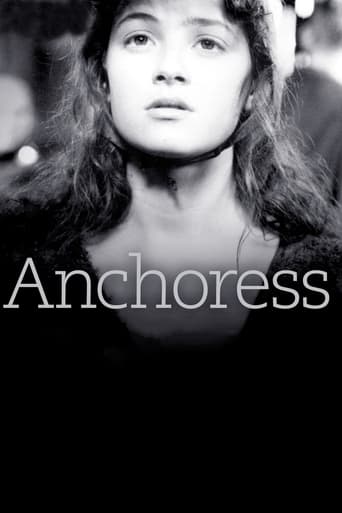



This movie feels like it was made purely to piss off people who want good shows
View MoreI think this is a new genre that they're all sort of working their way through it and haven't got all the kinks worked out yet but it's a genre that works for me.
View MoreStrong acting helps the film overcome an uncertain premise and create characters that hold our attention absolutely.
View MoreThe movie really just wants to entertain people.
Newby's film is based on the true story of Christine Carpenter, who in the 14th century was renounced as dead to the living world by the church, and enclosed as an anchoress for the rest of her life in the wall of a village church in Shere in Surray. The inspiration for the film, according to screenwriter Judith Stanely-Smith, was a letter concerning Christine written by the Bishop of Winchester in 1324.In the film Christine, a 14-year old illiterate peasant girl, finds herself drawn to a statue of the Virgin Mary. Meanwhile the village priest and "reeve" (Sheriff) are increasingly drawn to the beautiful Christine. The reeve proposed marriage to the girl, but Christine refuses the offer to the dismay of her mother, Pauline. Instead at the urging of a priest Christine becomes an anchoress so she can live next to the statue she so adores (and escape the possibility of marriage to the reeve). Her mother Pauline does not like her decision and plots against the priest. When Pauline, the village doctor and midwife, delivers the illegitimate stillborn child of the priests lover, the priest begins to plot against her. He accuses her of witchcraft and Pauline is killed by a mob. Meanwhile Christine has escaped from her cell through a tunnel and flees with her lover to Winchester to seek release from her vows from the Bishop there. The Bishop refuses and she "escapes" to run away with her love (although the ending scene is ambiguous if she really found freedom or a new kind of prison).Historically, the film is very accurate and instructive to understanding on an emotional and personal level the idea of Christian sexual renunciation and asceticism in the Middle Ages. The film also portrays well the interactions between secular and ecclesiastical powers over the lives of peasants. The reeves French-like accent is very accurate as a Norman lord (although the bald head is questionable). The Bishops Mediteranian accent and Latin language is also accurate. This film will appeal to anyone with an interest in the Middle Ages and history.
View More"Anchoress" (English/Dutch): I've watched this one over and over. I don't own it yet, but I will. It is fascinating, beautiful, strange, and insightful. "Anchoress" takes place during the European Medieval period, when humans survived at the mud level. This story is about one young woman who tries to find comfort and beauty inside the church,with the 'Mother Mary'...or at least a poorly made icon. She hasn't the capability of deciphering her motives, and soon offers herself to the church as an "Anchoress" - a person devoted to God, relinquishing all worldly connections, and being voluntarily cemented into a small crawl space of her church's wall (!) - for the rest of her life. Strange times, those...except we see that the priest considers this a good marketing move for the church (to have such an "attraction"). Yet, things don't go the way anyone predicted... "Anchoress" is shot in some of the most powerful black & white film I've ever seen (equal to Bergman or Lynch), has an incredibly sensitive sound track (not music) attuned to the daily life of Earth, and, a camera that loves to be thoughtful and intimate. Each shot is a composed, artful image worthy of Rembrandt. If Rembrandt had used a movie camera, with b/w film, this could've been one of his films. Despite, or because of, the near total lack of dialog, there are scenes you will never forget. This is a very grounded film, while being mystical at the same time. Perhaps that's part of the attraction. It deals with our dual urges to rise above daily life, yet revel in it at the same time. I understand more upon each viewing of "Anchoress".
View MoreThis film must be watched with a quiet spirit and a willingness to let go of well-organized, linear plot development. Those familiar with The Book of Margery Kempe will appreciate the spiritual struggle Anchoress represents as well as the more "feminine" approach to plot. The cinematography is exquisite as well as the acting.
View MoreExquisitely spare cinematography and striking visuals which ape Andrei Tarkovsky's ANDREI RUBLEV cannot save this medieval tale from being a disappointment. English director Chris Newby's first feature is a dismally muddled array of images of life in a remote 14th-century village. Talented young thespian Natalie Morse (of Peter GreenawayÕs DROWNING BY NUMBERS) nevertheless succeeds in her tricky role as Christine Carpenter, a girl touched by transcendent grace, who succumbs to the misguided religious authority of the times and becomes an anchoress, a virgin who is walled up in a chamber in the church, to serve as a moral beacon for the villagers.This makes the snickering local priest (Christopher Eccleston) overjoyed, as he takes her away from the Reeve (Eugene Bervoets, of the original French-Dutch production of THE VANISHING), the local military power monger. She is periodically visited by her surly pagan mother (English new-wave personality Toyah Wilcox) and pretty much ignored by her father, who is played by Pete Postlethwaite.The only real power in the film is in the scenes with Christine alone, discovering her sensuality. The rest of the film is a mess, partly due to the confusing, overly obscure script, which hardly lets the audience know what's going on without benefit of reading a plot synopsis beforehand. It purports to observe the female condition through the ages, but ends up being mostly uninsightful and boring.
View More